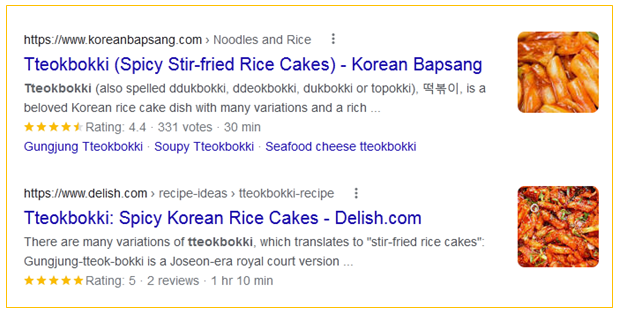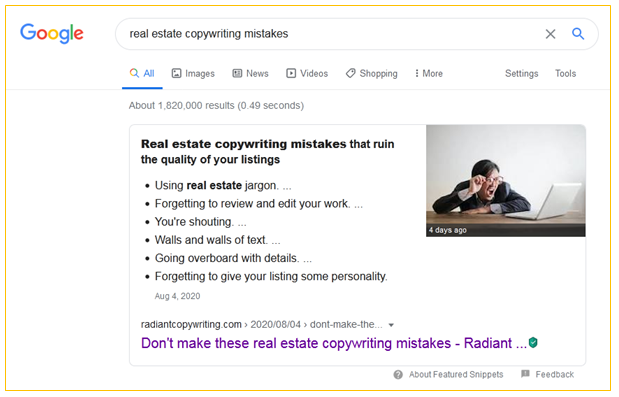Your no-nonsense guide on how to write SEO meta descriptions that will boost click-throughs—in just 5 steps!

To click or not to click: What gets users to click through to a particular page?
Run any kind of online search and you’re almost always presented with a plethora of page options to choose from—thousands, if not millions, of results!

What gets you to click through to a specific website? Or put another way: What motivates you to choose one particular page over another?
Chances are you evaluate your options based on the search snippets presented to you.
That is, you read SEO titles and compare meta descriptions that show up on the search engine results page (SERP). Only then do you click through to the ones that do the best job of addressing your search intent—or that pique your interest.
This search behavior is precisely why marketers need to pay extra attention to their own meta descriptions, especially if you’re a small or new business looking to attract as many qualified leads as possible to your website.
Before we get into how to write a meta description for SEO, we should first understand what a meta description is and where it’s found. Let’s go!
What is a snippet?
Search snippets, also called Google search snippets, are the automatically-generated sneak previews of a page’s content provided to users by search engines. What actually gets presented depends on the search terms a person uses as well as the meta data available for a page.
Snippets come in several formats:
Standard snippets
These types of search snippets are made up of a page’s title, URL, and meta description.

Rich snippets
A rich snippet is more detailed than a standard snippet in that it can also include pictures, ratings, location and other useful information relevant to the topic. In the example below, the snippet even highlights cooking / preparation time.

Featured snippets
This is perhaps where every marketer aspires to land their content: At the very top of the SERP!
Featured snippets are picked by Google and also come in different formats namely paragraphs, lists, tables, and even videos. Unlike the previous two, you have to actively work to optimize your pages to land this coveted spot.

What is a meta description?
A meta description is the ‘preview’ text you write for the snippet. They exist to help individuals like you and me know what to expect if we click through to that page.
In other words, page title and meta description work in tandem to convince searchers that a page has the answers, solutions, or products and services he or she is looking for.
Should you customize your meta description?
You might be wondering, if Google normally generates its own excerpt to fill up the meta description field of a snippet, why bother writing your own SEO meta descriptions to begin with?
There are still some very practical reasons to write meta descriptions for Google.
First, the meta descriptions you write will be used by Google approximately 37% of the time. While that’s not all the time, that’s still often enough that it should motivate you to want to write the best title and meta description for your pages.
Second, customizing your meta text can improve the quality and appearance of your snippet, so that it stands out among the 10+ results per page—and gives individuals good reason to click on YOUR link, not someone else’s.
And third, while it’s not guaranteed that search engines will display your description the way you intended, customization allows you to:
- Preview a page’s content in a way that aligns best with your brand
- Use your brand’s voice and tone from the earliest point of contact
- Focus on a message that you believe will resonate most with your target audience
By the way, did you know? When you hire me to write copy or content for you, I also include a sample meta description for your use or consideration. That’s one less thing for you to worry about!
How to write SEO meta descriptions
With my own site to manage, I’ve had to learn a thing or two about customizing page titles and meta descriptions to improve my click-through rate (CTA).
That is, how to make SEO meta descriptions enticing without resorting or falling victim to short shelf life tricks like keyword stuffing or clickbait. That insight is what I’ll be sharing with you.
Here, I’ve compiled no-nonsense tips on how to write meta descriptions for product pages, meta descriptions for blog posts, and how to write meta descriptions for SEO in general.
Tip #1: Follow meta description length recommendations—but don’t have sleepless nights about it
Let’s start with some practical information on a very frequently asked question: How long should a meta description be?
In 2019, meta description lengths were as follows:
- 158 characters or 920 pixels on Google
- 168 characters or 980 pixels on Bing
- 168 characters or 980 pixels on Yahoo
- 120 characters or 680 pixels on Mobile
What that means is you’re generally advised to keep your meta description between 50 and 160 characters for the best results. If your description exceeds the allotted space, it will simply get truncated and not display in full.
Here’s what that looks like:

Rather than stress about description length though, focus instead on writing a description that accurately outlines a page’s content. Equally, consider what kind of details you need to include in order to persuade searchers to click on your link. Finally, try to get the most important points across in your first 120 characters. That way, a few extra words (that get cut off) won’t necessarily ruin the message.
Takeaway: The ideal meta description is succinct yet compelling.
Tip #2: Write a useful description
A reliable way to get more clicks is to write descriptions that are actually helpful to your target audience. That means two things:
It’s an accurate description of the page’s content.
People want to know what they’ll find if they click through and they’re relying on your description to tell them what your page is all about. Keep in mind that writing a deceptive meta description will disappoint searchers and reflect poorly on your brand.
There’s a match between user intent and the page’s content.
Will your page give users what they’re looking for? For instance, there’s a difference between someone searching for a list of the best pillows for stomach sleepers and someone who wants to buy a pillow right now.
So how do you write a relevant meta description? Simple. You want to answer basic questions like:
- Who is this page / post for?
- What kind of problem is the searcher trying to solve?
- How is your page / post different from the other options on SERPs?
- What solution are you offering to someone who clicks through?
Takeaway: Write meta descriptions with the customer (or searcher) in mind.
Tip #3: Don’t forget keywords
An SEO meta description should include your most important (and relevant) keywords. You want to be strategic in how you use them though. In other words, work them into your text naturally (no stuffing, please) and in a way that makes sense.
Take a look at this snippet for gluten-free wedding cakes:

Search engines are more likely to deliver your website as an option when a user’s search terms match those in the meta description and, of course, on the destination page. In fact, you’ll see them highlighted in bold, like in the example above.
Tip #4: Encourage people to do something
Great meta descriptions motivate searchers to take action. After all, you want to entice people to click on your link, right?
Take a look at this awesome example:

It’s not pushy, it’s not overt—it’s tempting!
Doesn’t it make you want to click through and start creating your perfect muesli blend? I know I want to.
If you want to achieve something similar, use active voice and have a clear call to action.
Takeaway: Don’t be afraid to ask or even invite people to do something on your website.
Tip #5: Be yourself
You’re customizing meta descriptions because you want to stand out amidst the sea of options. The goal is to grab a searcher’s attention and get them to click through. To do that, your meta text shouldn’t be a replica of someone else’s—you want to be fresh and original. That’s why one of the best tips I can give you is to be yourself.

Takeaway: Have the confidence to do something different but always stay true to your brand tone and voice.
Bonus Tip: Don’t copy and paste meta descriptions for product pages
No matter how busy you get or how similar two products may be, always write a new meta description for that product page.
Also, if you don’t have the time to customize every single one of your meta descriptions for SEO, make sure you get them done for your most important pages. Those pages are:
- Your homepage;
- Product / service pages;
- High-traffic pages and content;
- And pages that are media-rich but that don’t have much text content on them.